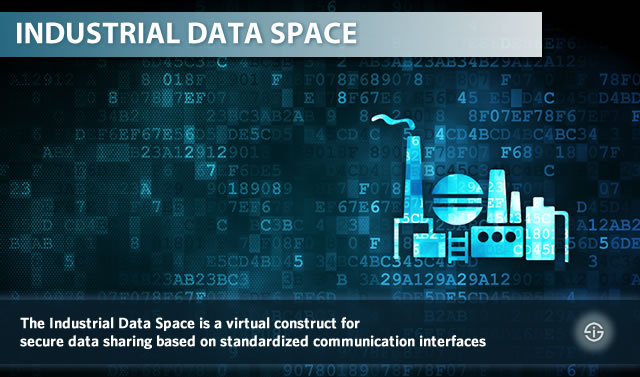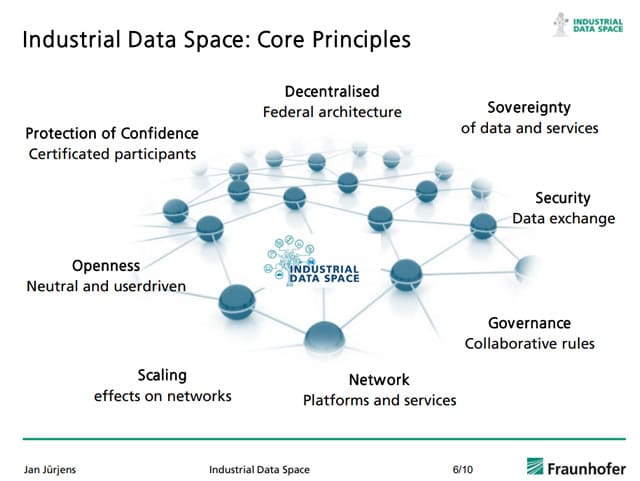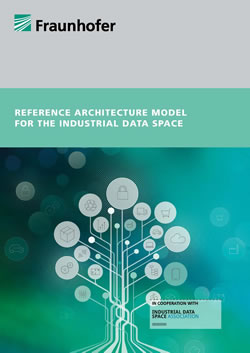In our Industry 4.0 overview we saw how data is critical in the whole vision, from the earliest possible stages of design, ideation and development to production and all the way further down the value network.
This prominence of data (and analytics) is also present in the RAMI 4.0 reference architecture of Industry 4.0 as mentioned in an article on industrial data and obviously in the broader perspective of digital transformation, its goals and the various technologies that enable it, from IoT (Internet of Things) to artificial intelligence and more. What does all this have to do with the Industrial Data Space, the topic of this article? A lot. Think data exchanges, smart services and new ecosystems of innovation and different business models. But there is more.

Industrial Data Space – going for a global standard
Let’s start with a quick update. Since 2014 the government of Germany (where the Industrie 4.0 concept was born, as was its nephew Energie 4.0) and researchers have been working on another data aspect that is crucial for Industry 4.0 and where Industrial Data Space comes in: secure data sharing as the essence of new services.
The Industrial Data Space goes further than Industry 4.0 alone though and finds applications in areas such as retail and life sciences to name a few.
Late Summer 2017, the German government and the Fraunhofer-Gesellschaft (which plays a keyrole as it did in ‘Industrie 4.0’) announced (PDF opens) that they are taking the Industrial Data Space model to the next level. And that next level is international. In other words: just like was the case with Industry 4.0 there will be more discussions, partnerships and lobbying going on (on top of what already is done) to push forward Industrial Data Space and its reference architecture. Do note that the Industrial Data Space is not the only initiative of its kind as you’ll read below.
On a practical level this plan to boost Industry 4.0 AND promote the Industrial Data Space globally also means that you’ll learn more about it at international industrial and industry-oriented IoT events at a location near you soon.
Industrial Data Space kicks off its post-Summer international tour at IoT Solutions World Congress 2017 in Barcelona (in 2016 it was already presented as you can see below). While the German government and industry certainly succeeded in making the profound digital transformation of manufacturing and other industries under the umbrella Industry 4.0 globally known (to the point that we’re even going through an Industry 4.0 hype whereby the foundations are not always understood), the question is if they can do the same with Industrial Data Space.
Data exchanges for digital transformation – connecting IoT and services
Before looking in depth at it, a short overview of data exchange evolutions as we already see them in Industrial IoT and other areas to paint the picture of context.
As you know data has become a business asset since several years and even more so since the advent of Big Data and related technologies. Again other technologies, of which several are prominent in Industry 4.0, add even more data to the equation. You can imagine the accelerating growth of data volumes with the Internet of Things alone.

As you also know, data as such is worth nothing. It needs to be gathered, combined and shared for particular purposes, among others leveraging advanced analytics and in data-intensive circumstances also leveraging artificial intelligence. Finally, all this data needs to be turned into actionable intelligence, (semi-)automated actions and ideally, the essence of digital transformation, into new services, platforms and revenue streams. The latter can even be totally different from a company’s core business and bring in entirely new customers: digital transformation as a way to get new customers and develop services for new markets instead of just improving customer experience indeed and again a reminder that, while customer experience is key, digital transformation is about much more (and about much more than just IT, marketing or digitization too).
Data monetization and data exchanges today are hot topics on many levels, among others in the Internet of Things. Vendors are looking for IoT data monetization models. Yet, obviously in the bigger picture, it’s not just about IoT data nor about immediate monetization alone.
Towards industrial data exchanges for innovation
The exchange and sharing of data (or access to it) is key for innovation and transformation at scale and in the more mature stages of digital transformation.

By way of an example: while the pharmaceutical industry used to work with clinical data today it disposes of public data, health records data from hospitals, sensor data, genetic data, you name it. The result is an accelerating increase of volumes and sources, which in turn increases the need for artificial intelligence.
Some leading companies in the Industry 4.0 and Industrial Internet space already did amazing things with the data they acquire by implementing novel strategies and/or by working with partners. Yet, how do you scale this within an industry, knowing the challenges at hand: security, trust, governance and data ownership? The answers differ per industry, purpose of the data and even function, with the most obvious one being marketing where it’s all data-driven marketing with ecosystems of data partners today (and where the topic of personal data protection also plays as it does in the Industrial Data Space).
Trust is key in establishing ecosystems of innovation, new business models and monetization in this connected age of IoT and Industry 4.0. While some see technologies as the answer to trust challenges, for example in the combination of blockchain and IoT, there is no such thing as a technology of trust as trust is a human given and in the scope of data exchanges on the level as we see it today (including the technologies which are leveraged such as IoT, big data, AI,…), in general more is needed to reach levels of trust in the eyes of the key beholders than yet another, albeit, extremely important technology, blockchain.
Industrial Data Space explained
A while ago we mentioned the launch of a new IoT data ecosystem for ecosystem-driven IoT data monetization for IoT device manufacturers and service providers and tackled how IoT data exchanges are the next IoT revolution.
All of this brings us to Industrial Data Space. It is broader than all the mentioned services and it’s not a platform but in the end aims to achieve the same for other stakeholders and use cases by a connection approach: the exchange of industrial data in a context of Industry 4.0 – and as mentioned other areas such as life sciences, logistics and retail – to create smart services and innovations by leveraging data from certified trusted partners, the data owners. Or shorter: connecting IoT and smart services.
The Industrial Data Space wants to let these data owners keep control over their own data and be able to enforce their own data privacy guidelines as you can read on the site of the Industrial Data Space Association.
You can see the future of Industrial Data Space as a true space but then a virtual one: in other words, an exchange (model) with the fundamental principles being data security and data sovereignty. However, as Boris Otto, Managing Director at Fraunhofer ISST, puts in a SlideShare presentation, “the Industrial Data Space is not another cloud platform, but rather connects various existing platforms and smart devices”.
The goal is obviously to enable industrial players and partners to develop their new services and business models. And it’s the data owner and the scope of the service/model that defines which kind of data are needed whereby, now and then, patterns from data can be enough.
The list of members of the Industrial Data Space Association is already pretty impressive with institutions, consultancies and several – mainly German- giants from several industries (Allianz, Bayer, Siemens, ThyssenKrupp, Volkswagen and Chinese Huawei). We’re pretty sure that after all the events were the Industrial Data Space Association is present that list will have considerably grown.
The Industrial Data Space Reference Architecture Model
You might ask “great, how do I join?”. Hold your horses a bit longer as we are still in the stage of a reference architecture for Industrial Data Space and interfaces. The goal, indeed, is to make it an international standard where the international collaboration and lobbying comes in.
So, just as you have a reference architecture for Industry 4.0 (RAMI) and as there are various reference architectures elsewhere (e.g. in Industrial Internet), you now have an Industrial Data Space Reference Architecture Model, you can get it (published 2017) in PDF here.
The reference model has several layers: a business layer, a functional layer, a process layer, an information layer and a system layer and it tackles various ‘perspectives’, among others on the level of governance, certifications and security. Theoretically, blockchains could play a role in several aspects of specific layers (e.g. the contract). The 82-page document is pretty comprehensive and in case you’re interested you can of course also join the association and, for instance, collaborate in one of the workgroups or on specific use cases.
Will Industrial Data Space become an international standard? We have no crystal ball but we do now that twelve Fraunhofer Institutes have been working on it (with a funding of 5 million Euros), that the Industrial Data Space which Fraunhofer calls “a virtual construct for secure data sharing based on standardized communication interfaces” is ready to go global and that discussions have already been conducted with the Industrial Internet Consortium in the US and the Japanese Industrial Value Chain Initiative who developed similar reference architectures. According to the press release that announces the next steps there are quite some other countries where adoption and/or interoperability has been discussed.
The keywords to remember are probable data sovereignty, control and data security, all topics that resonate very well globally and from the personal data perspective certainly also in the EU.
Top image: Shutterstock – Copyright: Maksim Kabakou – All other images are the property of their respective mentioned owners.

